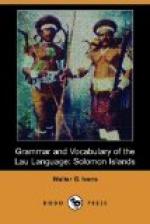Compound nouns may be formed, girigiri lifoa gnashing of teeth, saitama dooa wisdom.
Where in the vocabulary fa and ta have a hyphen attached, it is intended to show that they are used only with the suffixed pronoun attached.
There are certain adjectives to which the termination la is attached, diena good, dienala goodness, baita big, baitala bigness, and tasa in excess, tasala excess. It is probable, however, that these words are really verbs.
b. Independent nouns: The only termination is na, and this is added (1) to certain nouns which express relation ship or kindred; (2) to cardinal numerals to form ordinals. 1. Nouns so formed are always preceded by a prefix which marks reciprocity of relationship or kindred, mwai, and by the numeral ro two; sasi brother, ro mwai sasina the two brothers, te mother, ro mwai telana wife and child.
2. Numerals: olu three, oluna third.
3. Construct form: To make a construct form the letter e is added to the first of two nouns, toloe fera hill, fuli abae ai men’s handwork. When the first member ends in a the ae sometimes contracts to e, fufue ai seed, aqale mwai ten baskets, but maae rodo, a night; also when the first noun ends in o the oe is contracted to e: abole ai a log, abolo a piece. This e may be added to words which have not a distinct noun termination: naoe gula the chief place.
4. Genitive relation: The genitive relation of nouns one to another is effected by the use of the propositions ni and i: ni is used mainly in construction: baea ni sugela deceitful words, gwai ni gwaila anointing oil; ni expresses purpose: si gula ni lea inia a place for him to go to, rosuli ni manatai gami hear us in mercy. In certain words li replaces ni: maalimaea enemy, maalitafa a channel in a reef; i is used also to denote purpose: lea i fasifa came to sell it. Location, which also denotes place whence, is shown by i, geni i Saa, a Sa’a woman. Si is used in certain phrases: ofu si doo bundles, ro tooni si doo two thousand.
The genitive is frequently omitted olu teu flour, three measures of flour, mumudi fangala crumbs of food, mwane Saa, a Sa’a man, falisi vine a vineyard.
The possessive ana may be used to denote the genitive: luma ana foaa house of prayer, tala ana fanualama way of peace. A genitive relation is also shown by the use of the suffixed pronoun of the third person singular or plural in agreement with the idea expressed in the second noun of the pair: i tolona fera on the tops of the hills, gwouda na ai gi men’s heads.




